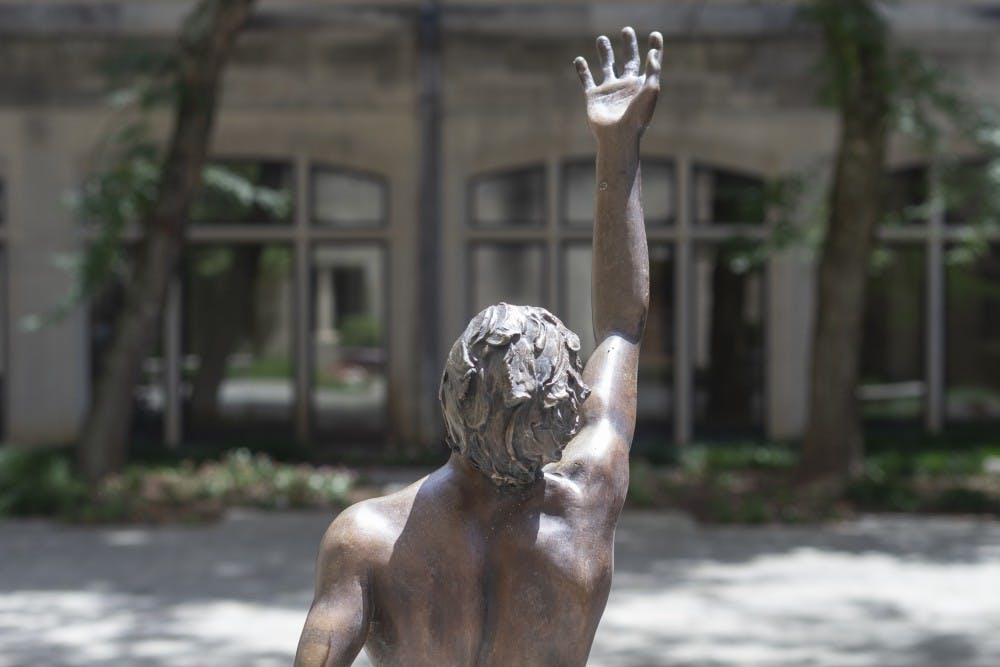Inside the Commemorative Garden located on the south side of the Indiana Memorial Union is a statue.
It sits atop a marble base, and its bronze color differentiates it from the limestone walls and plants surrounding it in the garden.
Standing 4 feet, 6 inches tall and weighing 200 pounds, William Snapp’s “SOUL” statue was already a compelling, if hidden, fixture on the IU campus.
However, during the 1990s and early 2000s, the statue would entrench itself in IU lore as it repeatedly left, and returned, to its spot in the garden.
According to an Indiana Daily Student article from October 2002, Snapp began sculpting “SOUL” in 1972 in the Education Building on the IU campus, while Snapp was at IU on a campus ministry. It took him 23 years to sculpt “SOUL” from start to finish.

“SOUL” stands for Search of Universal Life, as the statue depicts a man reaching toward the sky, standing on top of the world with one foot on the United States and one foot on Russia.
An inscription on one side of the sculpture’s base reads, “This figure stands on earth in hope that the USA and USSR will jointly endeavor to establish a worldwide ban against nuclear warfare in order to preserve the planet for future generations.”
On another side of the base, a second inscription reads, “This sculpture embodies the human quest for knowledge.”
An IDS article from December 2003 said Snapp had dedicated more than 40 years of his life to trying to place copies of the “SOUL” statue in both Washington, D.C., and Russia, in hopes of improving relations between Russia and the United States. According to the article, Snapp wrote to governors and senators, and reached out to non-profit organizations in Washington, D.C., for help.

Snapp, who first thought of the idea for the statue in 1963, donated “SOUL” to IU in 1989 in memory of his father, who died in 1960, and in honor of his mother. At age 91, Snapp’s mother also attended the sculpture’s dedication.
Herman B Wells, an acquaintance of Snapp’s according to a past IDS article, even helped arrange for the statue to arrive on campus.
Soon after its arrival, though, the statue began its nomadic lifestyle.
The IDS article from 2002 states that around 1995, the statue was stolen for the first time, before being found in a utility tunnel. Then, in 1997, someone attempted to steal the statue again, but was unsuccessful, although the marble base broke in half.
Like almost everything else in the state of Indiana, the statue eventually had its run-in with the sport of basketball.
On the night of April 1, 2002, the IU men’s basketball team lost the NCAA Championship game to Maryland. That same night, the statue went missing again, according to the Whittenberger Society Alumni Newsletter from summer 2003.
The Indiana University Police Department suspected students stole “SOUL” as a “souvenir.”
“I can’t imagine who would do it,” Snapp told the IDS in October 2002, while the statue was still missing. “I would like to think it's not college students. I don't believe a student studying at IU would be of that caliber."
Despite efforts to recover the statute, it remained missing for almost a year. The IMU even made plans to recast the statue at an estimated cost of $10,000 as part of a renovation project in the garden, according to the newsletter.
In early 2003, though, a group of IU students discovered the statue in the woods of Cascades Park, and the students’ landlord identified the statue as “SOUL.”
After reporting the discovery to IUPD, the statue was returned to the IMU on Feb. 14, 2003, according to the newsletter.
“I had been pretty sad and pretty concerned,” Snapp told the IDS in December 2003, after the statue was returned. “I felt such a healing.”
While the statue was placed back in the garden in summer 2003, it is now off to the side of the garden, instead of being in the center.
The “SOUL” statue may not occupy the same space it once did, but it remains safe and secure within its traditional limestone and shrub-filled home, as opposed to the other environments it has been a part of during its lifetime.






